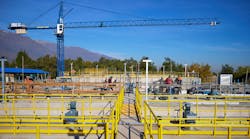Memthane, Veolia’s Anaerobic Membrane Bio-Reactor (AnMBR), delivers high-energy efficiency and quality effluents, enabling wastewater treatment system clients to simultaneously save money and improve their environmental performance.
An innovative yet simple process, Memthane, developed by Veolia’s subsidiary Biothane, combines two technologies with proven track records: Biothane’s anaerobic biological wastewater treatment and Pentair X-Flow's ultrafiltration (UF) membrane-separation process. Influent is fed to the anaerobic bioreactor where the organic components are converted into energy-rich biogas. Next, the anaerobic effluent is processed through the UF membrane unit, separating the ‘clean’ permeate from the biomass. The biomass is returned to the bioreactor, while the ultra-clean filtrate is discharged as particle-free, low biochemical oxygen demand/chemical oxygen demand effluent, often at levels low enough for direct discharge to the sewer.
In addition to its performance advantages, Memthane delivers significant reduction in total operating costs compared with other technologies, taking into account all elements, including membranes, chemicals, sludge disposal and overall energy savings. The simple, single, fully automated reactor system also offers the possibility of remote control.
Sustainable and profitable
Memthane opens the door to treating high-strength, high-solid wastes found in industries such as distilleries, dairies (whey), bio-ethanol producers and instant coffee plants, which were previously considered untreatable from an economic standpoint. Memthane is not just an Anaerobic MBR technology, but a small footprint solution that offers an array of benefits, reducing disposal costs while generating valuable biogas and remaining easy to operate and maintain.
Memthane maximizes renewable energy production while producing quality effluent that can be discharged directly to the sewer or often easily reused. The suspended free effluent can also facilitate easy recovery of nutrients for fertilizer production. With a COD removal efficiency of >98%, this powerful green energy source offers the possibility of making production plants energy self-sufficient, reducing the dependency on costly external fossil fuels.
Source: Veolia

